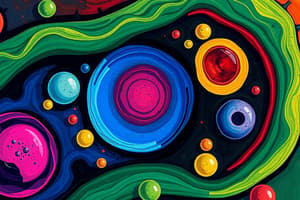Podcast
Questions and Answers
What is the primary function of the mitochondria?
What is the primary function of the mitochondria?
- Generating energy through cellular respiration (correct)
- Waste management
- Cell signaling
- Protein synthesis
Which organelle is responsible for protein modification and transport?
Which organelle is responsible for protein modification and transport?
- Endoplasmic reticulum (ER)
- Lysosomes
- Ribosomes
- Golgi apparatus (correct)
What is the jelly-like substance inside the cell where metabolic processes take place?
What is the jelly-like substance inside the cell where metabolic processes take place?
- Cytosol
- Plasma membrane
- Cytoplasm (correct)
- Nucleus
What is the function of lysosomes?
What is the function of lysosomes?
What is the process of creating new cells through mitosis or meiosis?
What is the process of creating new cells through mitosis or meiosis?
What is the function of the nucleus?
What is the function of the nucleus?
Flashcards are hidden until you start studying
Study Notes
Structure and Components
- Plasma membrane: a thin, semi-permeable membrane that separates the cell from its environment
- Cytoplasm: a jelly-like substance inside the cell where metabolic processes take place
- Cytosol: a clear, watery liquid within the cytoplasm where many metabolic reactions occur
- Organelles: specialized structures within the cell that perform specific functions
- Nucleus: the control center of the cell where DNA is stored
- Mitochondria: the powerhouses of the cell, responsible for generating energy through cellular respiration
- Endoplasmic reticulum (ER): a network of membranous tubules and cisternae involved in protein synthesis and transport
- Ribosomes: small organelles found throughout the cytoplasm, responsible for protein synthesis
- Lysosomes: membrane-bound sacs containing digestive enzymes, involved in cellular digestion and recycling
- Golgi apparatus: a complex of flattened sacs and tubules involved in protein modification and transport
Functions
- Metabolism: the process of converting energy and nutrients into the components of life
- Protein synthesis: the process of creating proteins from amino acids
- Cell signaling: the process of communicating with other cells and responding to environmental stimuli
- Waste management: the process of breaking down and recycling cellular waste
- Cell division: the process of creating new cells through mitosis or meiosis
Specialized Cells
- Nerve cells (neurons): specialized for transmitting information and controlling muscle and gland activity
- Muscle cells: specialized for contraction and movement
- Epithelial cells: specialized for protecting the body and regulating the exchange of substances
- Connective tissue cells: specialized for supporting and connecting the body
Cell Size and Shape
- Cell size: varies greatly depending on the type of cell, with some cells being only a few micrometers in diameter
- Cell shape: also varies depending on the type of cell, with some cells being spherical, cuboidal, or elongated
Cell Structure
- Plasma membrane is a thin, semi-permeable membrane that separates the cell from its environment.
- Cytoplasm is a jelly-like substance inside the cell where metabolic processes take place.
- Cytosol is a clear, watery liquid within the cytoplasm where many metabolic reactions occur.
- Organelles are specialized structures within the cell that perform specific functions.
- Nucleus is the control center of the cell where DNA is stored.
- Mitochondria are the powerhouses of the cell, responsible for generating energy through cellular respiration.
- Endoplasmic reticulum (ER) is a network of membranous tubules and cisternae involved in protein synthesis and transport.
- Ribosomes are small organelles found throughout the cytoplasm, responsible for protein synthesis.
- Lysosomes are membrane-bound sacs containing digestive enzymes, involved in cellular digestion and recycling.
- Golgi apparatus is a complex of flattened sacs and tubules involved in protein modification and transport.
Cell Functions
- Metabolism is the process of converting energy and nutrients into the components of life.
- Protein synthesis is the process of creating proteins from amino acids.
- Cell signaling is the process of communicating with other cells and responding to environmental stimuli.
- Waste management is the process of breaking down and recycling cellular waste.
- Cell division is the process of creating new cells through mitosis or meiosis.
Specialized Cells
- Nerve cells (neurons) are specialized for transmitting information and controlling muscle and gland activity.
- Muscle cells are specialized for contraction and movement.
- Epithelial cells are specialized for protecting the body and regulating the exchange of substances.
- Connective tissue cells are specialized for supporting and connecting the body.
Cell Size and Shape
- Cell size varies greatly depending on the type of cell, with some cells being only a few micrometers in diameter.
- Cell shape also varies depending on the type of cell, with some cells being spherical, cuboidal, or elongated.
Studying That Suits You
Use AI to generate personalized quizzes and flashcards to suit your learning preferences.




